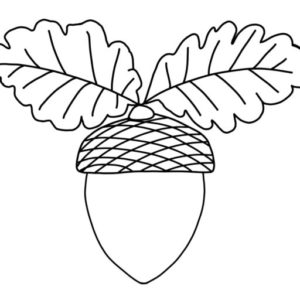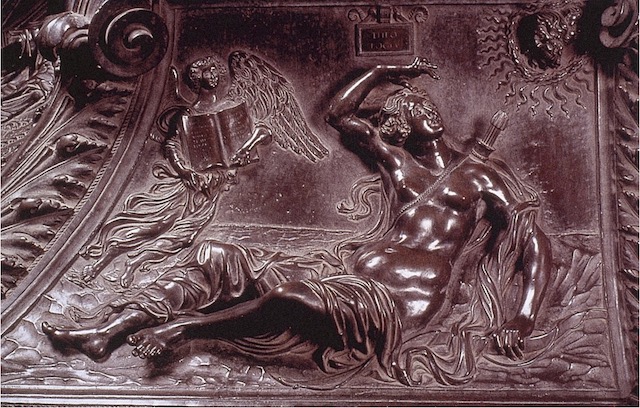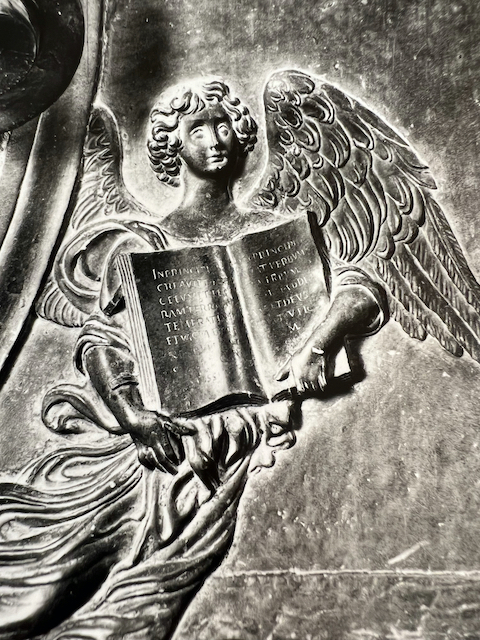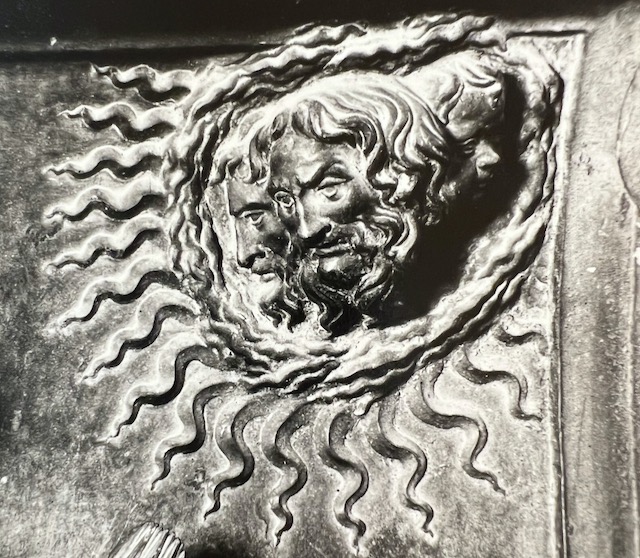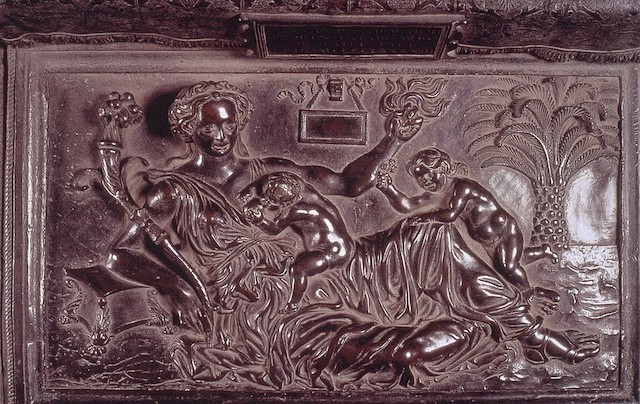Theology
Theology (figure 41) is shown next to Philosophy, in the same reclining pose as the other figures. An angel on the left holds an open book (figure 42) upon which is inscribed a quote from the book of Genesis, “In the beginning God created the heaven and the earth. And the earth was without form and void, and darkness was upon the face of the deep.”[107] The other page comes from the first sentence of the Gospel according to John, “In the beginning was the Word, and the Word was with God and the Word was God.”[108] These two passages convey the concept of Logos, or that the notion that the Word existed before time, providing reason, order, and meaning to the world and heavens.[109] According to Philo Judaeus or Philo of Alexandria, a first-century Jewish philosopher, Logos served as an agent through which human beings could understand grasp God. The selection of these passages invokes the theories of Logos and the divine, allowing the discipline of Theology to serve as a representative of Logos. Thus, the figure of Theology was a means through which scholars could comprehend God as Logos was Christ himself, the Word made flesh.
The winged angel hovers above the background which through its carved texture evokes the movement of water. The association of Theology to water is further established via the next line of Genesis following the inscription, reading “And the Spirit of God moved upon the face of the waters.” Theology holds her right hand above her head, shielding herself from the light of the Trinity, shown in the top right corner. This depiction of the trinity is represented as a three-faced head (figure 43) with curvilinear lines emanating from it, much like the light of God is shown in ascension images. Additionally, the sun signifying truth relates to the Neo-platonic belief that light would illuminate all truth.[110] This directly contrasts with Aristotelian thought displayed through inscription on Philosophy. However, it does show that these two are connected as the panels of Theology and Philosophy reflect the two variations in classical thought, Neo-Platonic and Aristotelian. The direction of their gazes further establishes the association between each discipline as Theology looks up towards the heavens, evoking Plato’s understanding of the universe established in his Theory of Forms as being established by a divine creator while Aristotle understood the world to have choices as established in his theories of concrete particulars. This contrast is most famously reflected in the later fresco by Raphael, depicting Plato and Aristotle within Philosophy, in the Stanza della Segnatura.
Scholars have argued that Theology was represented as the goddess Diana, hence the inclusion of the bow and quiver.[111] Although somewhat unusual to represent Theology as Diana, there is evidence that this figure emerged from the writings of Cardinal Adriano Castellesi in his poem Venatio, where Diana essentially ends the reign of the pagan gods with her praise of the Christian God.[112] Further, Diana has an established association with the moon or Luna, which was an image used to “express the divine inspiration of the church.”[113] Ettlinger continues this line of argument, writing that Theology is distinguished from all the other Arts and Sciences as these figures are shown entrenched in their work, studying their respective disciplines whereas the figure of Theology is “absorbed in the revelations of divine wisdom.”[114] Thus, wisdom is established as the central element to Theology, through the divine wisdom imparted in the word of God, in the head of the Trinity.[115]
Within the location where it was originally intended, the tomb would have been placed with the figures of Theology and Philosophy facing the altar wall which was likely decorated with an image depicting the Assumption of the Virgin.[116] Further, the ‘Cappella del Coro’ or the old Sistine chapel within Old St. Peter’s, established by Sixtus was dedicated to the Immaculate Conception. Promoted by the Franciscans and notably by Sixtus IV himself, it can be inferred that this tomb would have incorporated aspects of this doctrine into the tomb; he even established a Calendar Day for the celebration of the Immaculate Conception in 1477 via a Papal Bull.[117] While the overall chapel was dedicated to the Virgin, the background within the Theology panel further aids in establishing the figure as a type for the Virgin Mary.[118] Unlike the other disciplines, Theology’s background shows much more texture, separating the smooth background of the sky and the rippling landscape below. Where Theology lies, almost looks like the texture of rock, as if she is sitting on a ledge. With her body and the Angel’s body serving as a boundary, curvilinear lines evoke waves or moving waters behind her. This, together with the textual inscription, alludes to the Congregation of the Waters, especially as depicted later by Michelangelo in his fresco on the Sistine Ceiling. Furthermore, the figure of Charity is placed above both Theology and Philosophy. Throughout the Bible, the Virgin as Charity is often referenced, especially as the Lady of Charity. As there were likely strong connections to the altar wall, this connection between the figure of Charity and the Virgin further establishes the interconnected relationship between Pollaiuolo’s tomb and the Chapel’s altar wall decoration. The figure of Charity (figure 44) more closely resembles the disciplines of the Liberal Arts versus the surrounding Virtues. Shown in a landscape panel, with a similar pose, the figure of Charity reclines, wearing a similar dress and interacting with her surroundings comparable to the figures of the Liberal Arts. Thus, a greater relationship can be identified between the figures of Charity, Theology, and the Virgin Mary on the altar wall.
Additionally, as Sixtus wrote many treatises and sermons, most relevant, his oratio on the Immaculate Conception, which was integrated into the chapel via both the altar wall and via his tomb imagery.[119] As has been previously argued, integrated the themes of the altar and potential tomb into the space of the Cappella del Coro, expanding the themes of his life and patronage into the whole artistic program of the chapel. Thus, Theology can be identified as a type for Diana, and by extension the Virgin Mary in relation to the overall dedication of the chapel and location of surrounding panels.[120]
Figure 41. Antonio Pollaiuolo, Tomb of Sixtus IV, Detail of Theologia, c.1484-1493
Figure 42. Antonio Pollaiuolo, Tomb of Sixtus IV, Detail of Angel with Inscription, c.1484-1493
Figure 43. Antonio Pollaiuolo, Tomb of Sixtus IV, Detail of the Trinity Head in Theology, c.1484-1493
Figure 44. Antonio Pollaiuolo, Tomb of Sixtus IV, Detail of Charity, c.1484-1493
